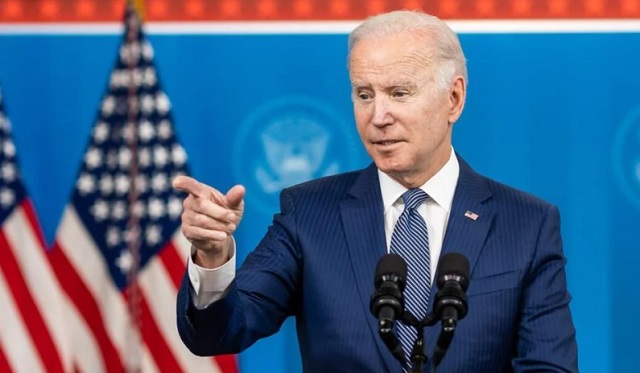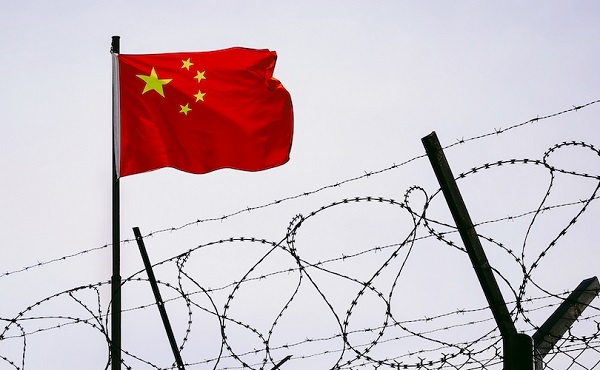Economy
Biden environmental agenda under fire for increasing costs for Americans

By Casey Harper
The Biden administration’s energy policies are increasingly costly for Americans, a newly released report says.
U.S. House Oversight Committee Chair Rep. James Comer, R-Ky., released the report, which argues Biden’s energy policies have increased costs for Americans and hurt the economy.
“The Biden Administration weaponized the power of the executive branch to wage a war against American-made energy production and cement in place radical, far-left energy policies that jeopardize domestic energy development, overload America’s power grid, and raise costs on all American consumers and businesses,” Comer said in a statement.
In particular, President Joe Biden’s recent pause on liquefied natural gas exports, elevated gas prices, and the aggressive push toward transitioning toward electric energy are among the main criticisms lobbed at Biden.
Comer’s office cites analysis from the right-leaning American Action Forum released in April. AAF reports that in 2024 alone, Biden’s Environmental Protection Agency, as of the end of April, had proposed 38 new rules and finalized 63 rules. According to AAF, those rules total 33,138 pages and will cost the U.S. economy over a trillion dollars.
The report also highlights the cost of pushing America’s energy needs increasingly to the electric grid.
From the report:
Even as use efficiency improves, the U.S. Energy Information Administration projects U.S. utility-generated electricity demand to continue growing at an average annual rate of one percent through 2050. But radical new policies and regulations promulgated by the Biden Administration seek to transform power generation and electricity markets. The Biden Administration is moving to replace highly reliable and affordable existing sources of energy with new sources that are typically less reliable and more expensive. For consumers, the results of these initiatives will predictably be higher costs on utility bills, higher costs for goods and services that consume electricity, invisible energy subsidy costs paid through income and other taxes, as well as economic costs as high electricity prices push some business opportunities overseas.
The White House has cited climate change concerns as it rolled out several policies, including a pause on new export sites for liquefied natural gas.
That LNG pause has been particularly controversial, with a coalition of state and Congressional leaders rallying opposition against it. A lawsuit challenging the constitutionality has been filed by a coalition of states.
Biden’s Department of Energy has defended the decision and stressed that it will not stop any currently existing sales. The White House has also argued that the U.S. is already a leading exporter without new sales.
“Before issuing any new LNG export decisions, DOE is embarking on a transparent process to ensure we are using the most up-to-date economic and environmental analyses to determine whether additional approvals of LNG exports to non-FTA countries are in the ‘public interest,” the DOE said in a February post defending the decision.
Meanwhile, federal climate-related spending has come under fire.
During a news conference last week, U.S. Sen. Shelley Moore Capito, R-W.Va., sparked headlines by exposing that federal funds went to a climate group that was actively supporting the Oct. 7 Hamas attack on Israel, an attack that included rape, killing children, and hostage-taking.
“We went to the website of Climate Justice Alliance. This is what we found on the website that our taxpayer dollars are going to organizations such as this,” she said, referencing a pro-Hamas photo reportedly found on the group’s website.
Comer’s reports come as Biden’s Secretary of Energy, Jennifer Granholm, took questions from lawmakers last week about Biden’s energy policies.
Republicans took her to task for the increased costs Americans are facing. Energy costs have risen over 35% since Biden took office, according to federal data.
During the hearing, Granholm defended her agency’s work, including Biden’s decision to drain the nation’s Strategic Petroleum Reserve earlier in his term to help address soaring gas prices.
“The Administration remains committed to maintaining a robust and well-functioning SPR. In 2022, in response to Russia’s invasion of Ukraine and the resulting disruptions in the oil market, the President directed the sale of 180 million barrels,” Granholm said in her written testimony. submitted to the committee. “The emergency sales provided supply certainty and acted as a bridge until domestic production increased, which in turn helped to mitigate the cost increases for American families.”
Business
Socialism vs. Capitalism

People criticize capitalism. A recent Axios-Generation poll says, “College students prefer socialism to capitalism.”
Why?
Because they believe absurd myths. Like the claim that the Soviet Union “wasn’t real socialism.”
Socialism guru Noam Chomsky tells students that. He says the Soviet Union “was about as remote from socialism as you could imagine.”
Give me a break.
The Soviets made private business illegal.
If that’s not socialism, I’m not sure what is.
“Socialism means abolishing private property and … replacing it with some form of collective ownership,” explains economist Ben Powell. “The Soviet Union had an abundance of that.”
Socialism always fails. Look at Venezuela, the richest country in Latin America about 40 years ago. Now people there face food shortages, poverty, misery and election outcomes the regime ignores.
But Al Jazeera claims Venezuela’s failure has “little to do with socialism, and a lot to do with poor governance … economic policies have failed to adjust to reality.”
“That’s the nature of socialism!” exclaims Powell. “Economic policies fail to adjust to reality. Economic reality evolves every day. Millions of decentralized entrepreneurs and consumers make fine tuning adjustments.”
Political leaders can’t keep up with that.
Still, pundits and politicians tell people, socialism does work — in Scandinavia.
“Mad Money’s Jim Cramer calls Norway “as socialist as they come!”
This too is nonsense.
“Sweden isn’t socialist,” says Powell. “Volvo is a private company. Restaurants, hotels, they’re privately owned.”
Norway, Denmark and Sweden are all free market economies.
Denmark’s former prime minister was so annoyed with economically ignorant Americans like Bernie Sanders calling Scandanavia “socialist,” he came to America to tell Harvard students that his country “is far from a socialist planned economy. Denmark is a market economy.”
Powell says young people “hear the preaching of socialism, about equality, but they don’t look on what it actually delivers: poverty, starvation, early death.”
For thousands of years, the world had almost no wealth creation. Then, some countries tried capitalism. That changed everything.
“In the last 20 years, we’ve seen more humans escape extreme poverty than any other time in human history, and that’s because of markets,” says Powell.
Capitalism makes poor people richer.
Former Rep. Jamaal Bowman (D-N.Y.) calls capitalism “slavery by another name.”
Rep. Alexandria Ocasio-Cortez (D-N.Y.) claims, “No one ever makes a billion dollars. You take a billion dollars.”
That’s another myth.
People think there’s a fixed amount of money. So when someone gets rich, others lose.
But it’s not true. In a free market, the only way entrepreneurs can get rich is by creating new wealth.
Yes, Steve Jobs pocketed billions, but by creating Apple, he gave the rest of us even more. He invented technology that makes all of us better off.
“I hope that we get 100 new super billionaires,” says economist Dan Mitchell, “because that means 100 new people figured out ways to make the rest of our lives better off.”
Former Labor Secretary Robert Reich advocates the opposite: “Let’s abolish billionaires,” he says.
He misses the most important fact about capitalism: it’s voluntary.
“I’m not giving Jeff Bezos any money unless he’s selling me something that I value more than that money,” says Mitchell.
It’s why under capitalism, the poor and middle class get richer, too.
“The economic pie grows,” says Mitchell. “We are much richer than our grandparents.”
When the media say the “middle class is in decline,” they’re technically right, but they don’t understand why it’s shrinking.
“It’s shrinking because more and more people are moving into upper income quintiles,” says Mitchell. “The rich get richer in a capitalist society. But guess what? The rest of us get richer as well.”
I cover more myths about socialism and capitalism in my new video.
Business
Residents in economically free states reap the rewards

From the Fraser Institute
A report published by the Fraser Institute reaffirms just how much more economically free some states are compared with others. These are places where citizens are allowed to make more of their economic choices. Their taxes are lighter, and their regulatory burdens are easier. The benefits for workers, consumers and businesses have been clear for a long time.
There’s another group of states to watch: “movers” that have become much freer in recent decades. These are states that may not be the freest, but they have been cutting taxes and red tape enough to make a big difference.
How do they fare?
I recently explored this question using 22 years of data from the same Economic Freedom of North America index. The index uses 10 variables encompassing government spending, taxation and labour regulation to assess the degree of economic freedom in each of the 50 states.
Some states, such as New Hampshire, have long topped the list. It’s been in the top five for three decades. With little room to grow, the Granite State’s level of economic freedom hasn’t budged much lately. Others, such as Alaska, have significantly improved economic freedom over the last two decades. Because it started so low, it remains relatively unfree at 43rd out of 50.
Three states—North Carolina, North Dakota and Idaho—have managed to markedly increase and rank highly on economic freedom.
In 2000, North Carolina was the 19th most economically free state in the union. Though its labour market was relatively unhindered by the state’s government, its top marginal income tax rate was America’s ninth-highest, and it spent more money than most states.
From 2013 to 2022, North Carolina reduced its top marginal income tax rate from 7.75 per cent to 4.99 per cent, reduced government employment and allowed the minimum wage to fall relative to per-capita income. By 2022, it had the second-freest labour market in the country and was ninth in overall economic freedom.
North Dakota took a similar path, reducing its 5.54 per cent top income tax rate to 2.9 per cent, scaling back government employment, and lowering its minimum wage to better reflect local incomes. It went from the 27th most economically free state in the union in 2000 to the 10th freest by 2022.
Idaho saw the most significant improvement. The Gem State has steadily improved spending, taxing and labour market freedom, allowing it to rise from the 28th most economically free state in 2000 to the eighth freest in 2022.
We can contrast these three states with a group that has achieved equal and opposite distinction: California, Delaware, New Jersey and Maryland have managed to decrease economic freedom and end up among the least free overall.
What was the result?
The economies of the three liberating states have enjoyed almost twice as much economic growth. Controlling for inflation, North Carolina, North Dakota and Idaho grew an average of 41 per cent since 2010. The four repressors grew by just 24 per cent.
Among liberators, statewide personal income grew 47 per cent from 2010 to 2022. Among repressors, it grew just 26 per cent.
In fact, when it comes to income growth per person, increases in economic freedom seem to matter even more than a state’s overall, long-term level of freedom. Meanwhile, when it comes to population growth, placing highly over longer periods of time matters more.
The liberators are not unique. There’s now a large body of international evidence documenting the freedom-prosperity connection. At the state level, high and growing levels of economic freedom go hand-in-hand with higher levels of income, entrepreneurship, in-migration and income mobility. In economically free states, incomes tend to grow faster at the top and bottom of the income ladder.
These states suffer less poverty, homelessness and food insecurity and may even have marginally happier, more philanthropic and more tolerant populations.
In short, liberation works. Repression doesn’t.
-

 Bruce Dowbiggin2 days ago
Bruce Dowbiggin2 days agoBe Careful What You Wish For In 2026: Mark Carney With A Majority
-

 Business20 hours ago
Business20 hours agoLargest fraud in US history? Independent Journalist visits numerous daycare centres with no children, revealing massive scam
-

 Energy2 days ago
Energy2 days agoNew Poll Shows Ontarians See Oil & Gas as Key to Jobs, Economy, and Trade
-

 Business21 hours ago
Business21 hours ago“Magnitude cannot be overstated”: Minnesota aid scam may reach $9 billion
-

 Alberta2 days ago
Alberta2 days agoAlberta project would be “the biggest carbon capture and storage project in the world”
-

 Business2 days ago
Business2 days agoSocialism vs. Capitalism
-

 Censorship Industrial Complex18 hours ago
Censorship Industrial Complex18 hours agoUS Under Secretary of State Slams UK and EU Over Online Speech Regulation, Announces Release of Files on Past Censorship Efforts
-

 Energy2 days ago
Energy2 days agoCanada’s debate on energy levelled up in 2025




